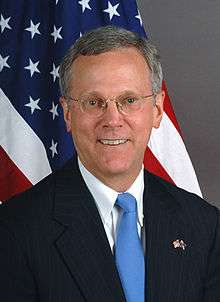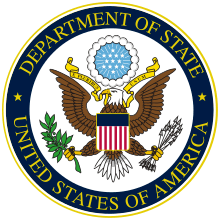Robert McCallum Jr.
| Robert McCallum Jr. | |
|---|---|
 | |
| 23rd United States Ambassador to Australia | |
|
In office 2006–2009 | |
| President | George W. Bush |
| Preceded by | Thomas Schieffer |
| Succeeded by | Jeff Bleich |
| United States Deputy Attorney General Acting | |
|
In office August 15, 2005 – March 17, 2006 | |
| President | George W. Bush |
| Preceded by | James Comey |
| Succeeded by | Paul McNulty |
| 14th United States Associate Attorney General | |
|
In office 2003–2006 | |
| President | George W. Bush |
| Preceded by | Jay B. Stephens |
| Succeeded by | Kevin J. O'Connor |
| Personal details | |
| Born |
Robert Davis McCallum Jr. 1946 (age 71–72) Memphis, Tennessee |
| Political party | Republican |
| Spouse(s) | Mary Rankin Weems |
| Alma mater |
Yale University; Oxford University |
Robert Davis McCallum Jr. (born 1946) is an American attorney and diplomat who served in the Bush administration. He was the Associate Attorney General of the United States from 2003 to 2006, also acting as the Deputy Attorney General from 2005 to 2006. He was appointed as the United States Ambassador to Australia in 2006, a capacity in which he served until the end of Bush's term in 2009.
Early life
McCallum was born in Memphis, Tennessee, where his father, Robert D. McCallum, was a businessman.[1] He was educated at Presbyterian Day School in Memphis and then at The Choate School (now Choate Rosemary Hall) in Wallingford, Connecticut, where he was a star tennis player and captain of the basketball team. He then went to Yale University, where he graduated in 1968. At Yale his roommate and fellow member of Skull and Bones was George W. Bush.[2][3] In 1968, McCallum was named a Rhodes Scholar and attended Oxford University in England. In 1969, he married Mary Rankin Weems ("Mimi") of Memphis. They have two adult sons, one of whom was also a Rhodes Scholar. McCallum graduated from Yale Law School in 1973.
Professional life
After completing his LL.B. at Yale in 1973, McCallum joined the Atlanta law firm of Alston & Bird. Philip Alston, one of the principals of this firm, was U.S. Ambassador to Australia under President Jimmy Carter from 1977 to 1981. McCallum remained with the firm for 28 years, before joining the U.S. Department of Justice in 2001 as Assistant Attorney General for the Civil Division. In this position, he oversaw litigation involving the defense of challenges to Presidential actions and acts of Congress; national security issues; immigration; benefit programs; commercial issues including health care fraud, banking, insurance, patents, debt collection; and the Food Drug and Cosmetic Act.
In July 2003 McCallum was appointed Associate Attorney General. He served as Acting Deputy Attorney General from September to December 2004 and from August 2005 until he resigned on being nominated as Ambassador to Australia.
In 2005 McCallum was accused of interfering with the government's prosecution of the tobacco industry by requiring Justice Department lawyers to cut their demand for an industry-sponsored smoking cessation program from $130 billion to $10 billion. During his ambassadorial confirmation hearings before the United States Senate, Senator Dick Durbin of Illinois raised this issue and demanded an investigation of McCallum's role. The Justice Department's Office of Professional Responsibility found no wrongdoing on McCallum's part. In her 2006 decision in the case, Judge Gladys Kessler placed limits on tobacco companies' abilities to market cigarettes, but found that a previous appeals court ruling prevented her (in the judicial branch) from requiring the industry to pay for a smoking cessation program.
Australia
McCallum had never been to Australia prior to his appointment and had had no previous involvement with the country, or indeed with foreign policy at all. The position of U.S. Ambassador to Australia is traditionally held by friends or political associates of the President, rather than by career diplomats, since Australia is a close ally of the U.S. and the post is considered a highly desirable one. The previous Ambassador, Tom Schieffer, was a business associate of President Bush.
In an interview with The Australian, a national daily newspaper, McCallum said that he had been attending seminars on Australian affairs since his appointment. "I feel that [from the seminars] I have got a good grounding in the fundamentals of what is going on in a very, very important relationship to the U.S. with Australia, and I'm eager to learn and experience that firsthand", he said. He said that he would seek to meet and establish close relations with Australian politicians of all parties, including those critical of U.S. policies.[4]
McCallum's arrival in Australia ended an 18-month period in which there was no U.S. Ambassador in Canberra. Following Schieffer's departure to take up the position of Ambassador to Japan in January 2005, the U.S. was represented by a Chargé d'Affaires, Bill Stanton, who also departed Australia before McCallum's appointment. The long delay was caused by the Bush Administration's apparent inability to find a candidate who was suitably close to the President but willing to undergo the scrutiny which accompanies the Senate confirmation process.
McCallum announced that he would resign his position following the inauguration of President Barack Obama in 2009, to make way for the next U.S ambassador to Australia and---as he was not close with Senators McCain or Obama---iterated his view that it is important for a US-Australia ambassador have a close relationship with the President.[5] He resigned from the position and left Australia on 20 January 2009.
See also
References
- ↑ http://www.rhodes.edu/NewsCenter/RhodesMagazine/Summer2005/CampusNews/Remembering-Trustee-Robert-McCallum.cfm
- ↑ "Leak Investigation: An Oversight Issue?", Newsweek, August 15, 2005
- ↑ Alexandra Robbins, Secrets of the Tomb: Skull and Bones, the Ivy League, and the Hidden Paths of Power, Little, Brown and Company, 2002, page 177, 181.
- ↑ http://www.theaustralian.news.com.au/story/0,20867,19941242-28737,00.html
- ↑ http://www.theage.com.au/world/us-election-2008/american-ambassador-takes-his-leave-of-australia-20081106-5jbo.html?page=1
External links
| Wikimedia Commons has media related to Robert D. McCallum, Jr.. |
- Appearances on C-SPAN
- Remarks to the American Health Lawyers Association Meeting, September 30, 2002.[1]
- United States Department of Justice recovers record $1.6 billion in fraud payments.[2]
- Statement of Assistant Attorney General Robert McCallum Jr. about the Third Circuit Decision issued in North Jersey Media Group v. Ashcroft, October 8, 2002.[3]
- Statement of Assistant Attorney General Robert McCallum Jr. following daily arguments in 9/11 Victim Compensation Fund Case, April 14, 2003.[4]
- New envoy a smart lawyer and friend of Bush
- Presidential Nomination: Robert Davis McCallum
| Legal offices | ||
|---|---|---|
| Preceded by David W. Ogden |
United States Assistant Attorney General for the Civil Division 2001–2003 |
Succeeded by Peter D. Keisler |
| Preceded by Peter D. Keisler Acting |
United States Associate Attorney General 2003–2006 |
Succeeded by William W. Mercer Acting |
| Preceded by James Comey |
United States Deputy Attorney General Acting August 15, 2005 – March 17, 2006 |
Succeeded by Paul McNulty |
| Diplomatic posts | ||
| Preceded by Tom Schieffer |
United States Ambassador to Australia 2006–2009 |
Succeeded by Jeffrey L. Bleich |
- ↑ Transcript
- ↑ "Justice Recovers Record $1.6 Billion in Fraud Payments; Highest Ever For One Year Period"
- ↑ "Statement of Assistant Attorney General Robert McCallum on the Third Circuit Decision Issued in North Jersey Media Group v. Ashcroft:"
- ↑ "Statement of Assistant Attorney General Robert McCallum Jr. following today's arguments in 9/11 Victim Compensation Fund Case"
